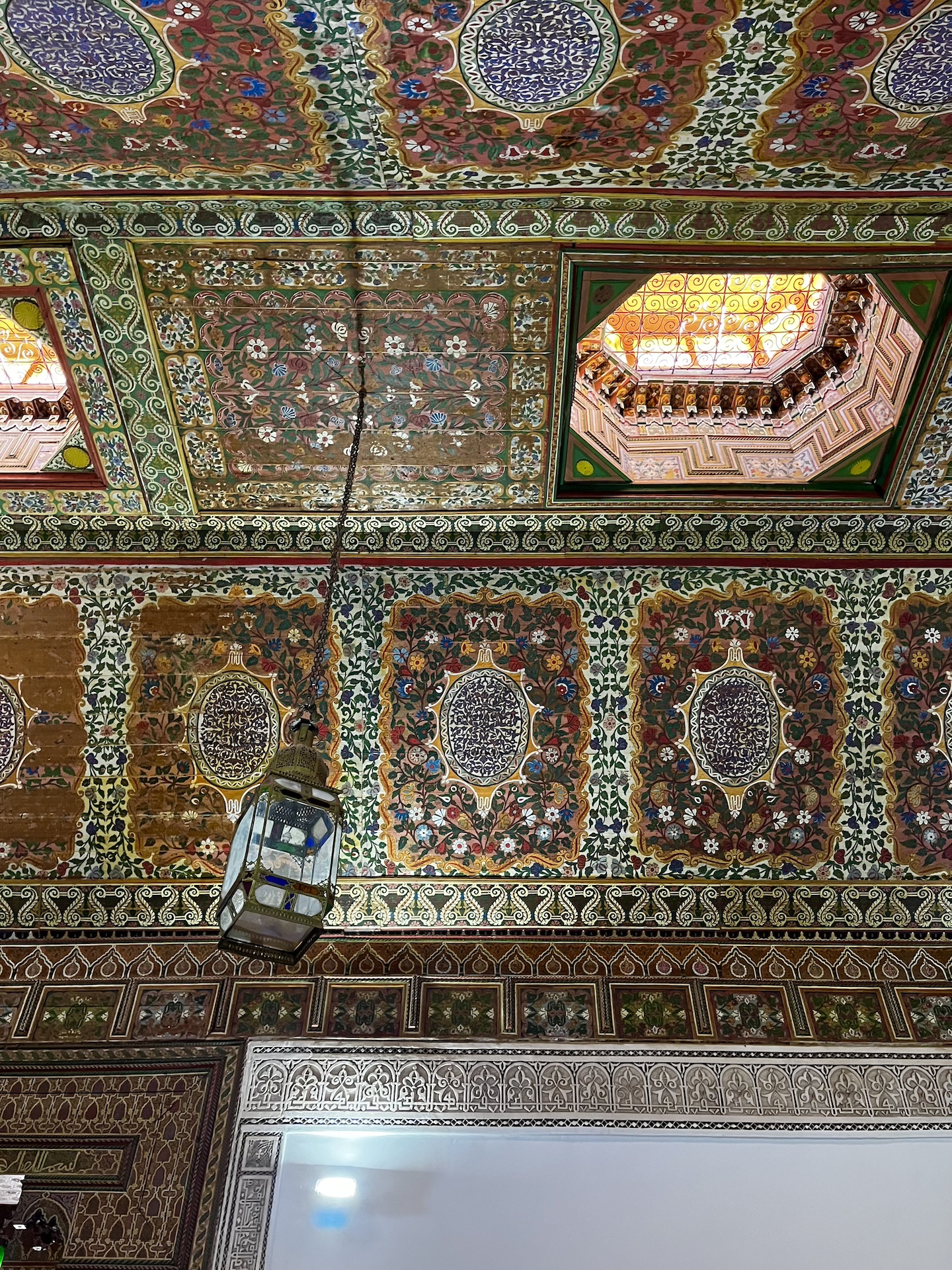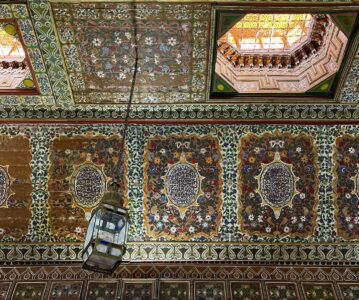We spent 7 days in the heart of Marrakech, even going the full hog and staying within the bustling Medina. Flying from Bristol to Marrakech Menara Airport, the journey took just under 4 hours, and the views flying into Morocco were incredible. Miles and miles of desert stretching on for what looked like forever!
This is an insight into what we got up to, but also some useful tips which would have been fab for us to know before heading out. I hope that this can help others too!
THINGS TO SEE
Kutubbiya Mosque
Kutubbiya Mosque, also known as Koutoubia Mosque, is the tallest structure in Marrakech and dominates the skyline. You can see it from any high point in the city, and serves as a visual anchor for the residents – this is because it stands at 77m tall!
This stunning mosque is a slightly further walk outside the centre of the Medina, but one which should not be missed. It was constructed in the 12th century and is known for its arches, the tiling and the gardens directly next to it. Many people visit, not only because it’s the landmark of Marrakech, but because of the religion, architecture and peacefulness that the mosque, along with the gardens, bring. At the time of writing, there’s no entry into the mosque other than for worship, but the walk around the exterior is free and leads you directly into the park opposite it – Park Lalla Hasna.
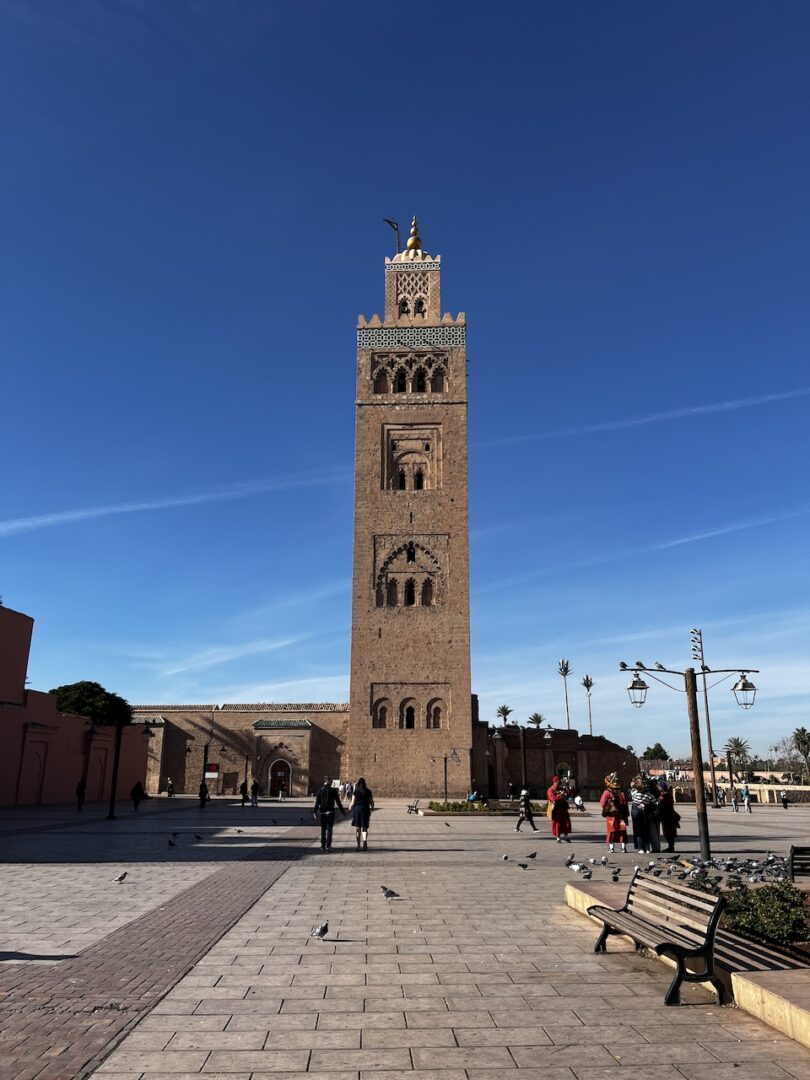
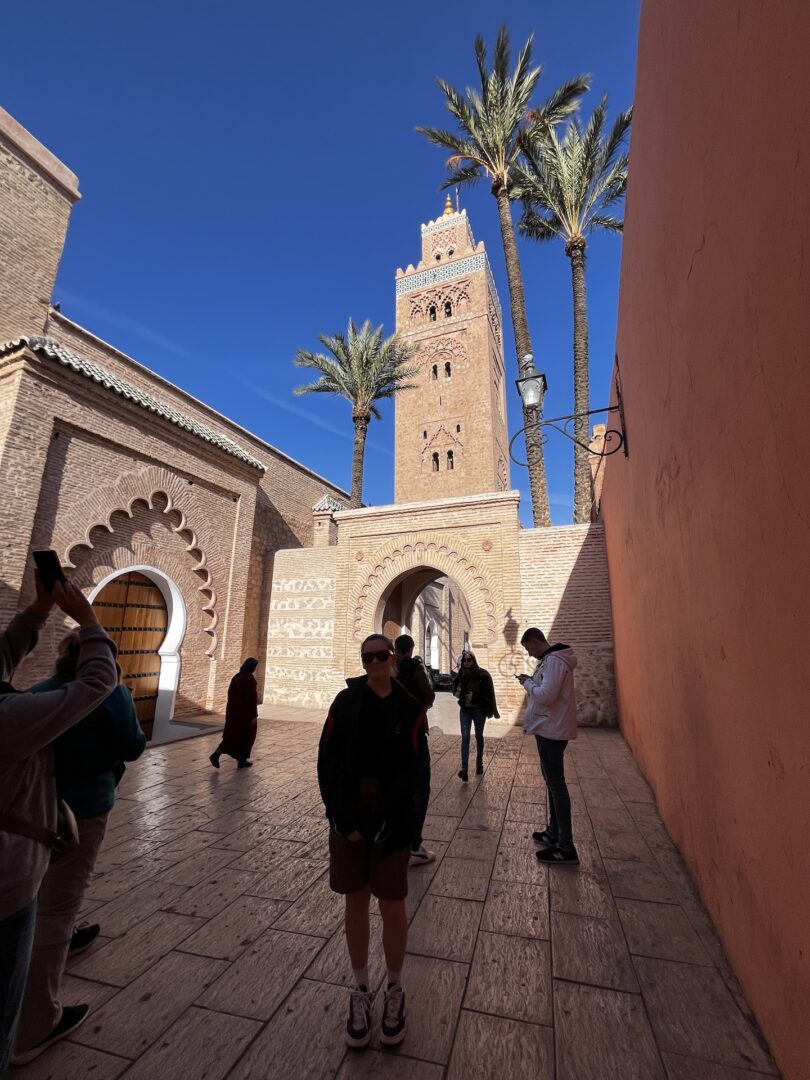
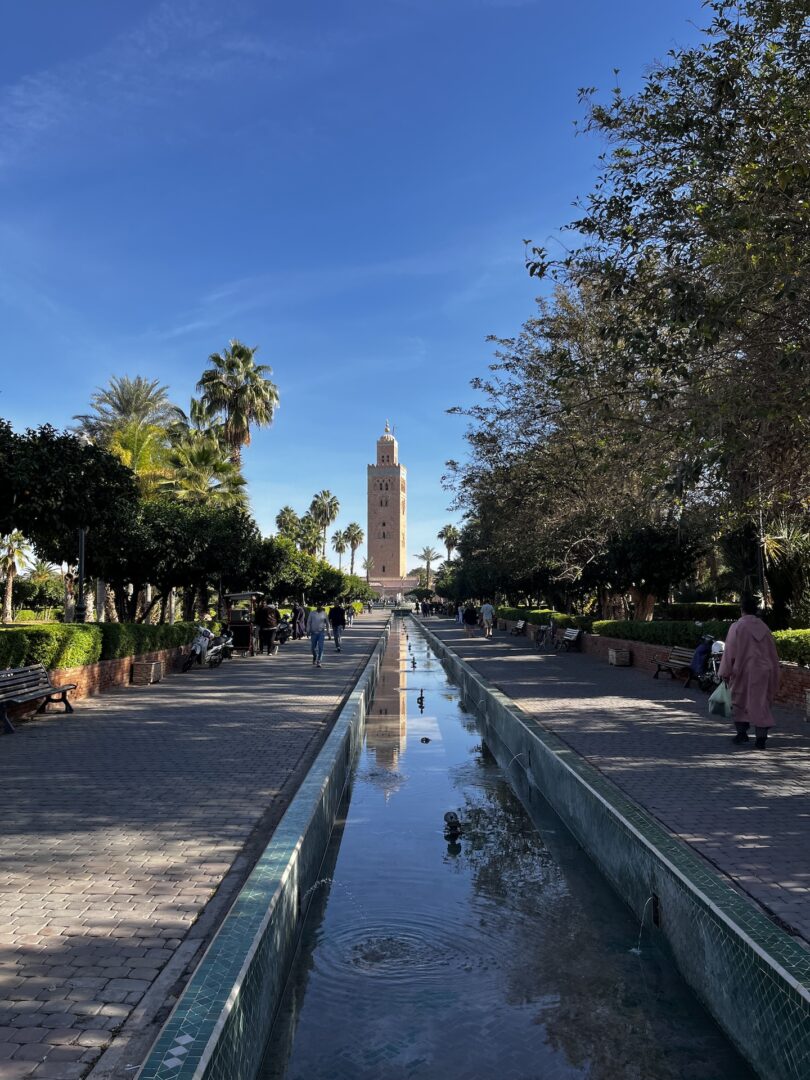
Ben Yousef Madrasa
Another mosque, but this time, one that is hidden in the centre of the Medina. This mosque was originally built as a school: a place of learning and a destination for students to learn more about philosophy, religious sciences, medicine and mathematics. It houses students, and also is home to a prayer room – the Madrasa contains over 130 rooms, and it could house over 900 students at one point! It was built in 1565 by Sultan Al-Ghaleb Assaadi and was a place for learning for over four centuries. It fell into disrepair and was abandoned due to the economic status of Morocco before being recognised for its historical significance and was repaired into the building we see today. It is now a popular tourist destination and an iconic landmark in Marrakech for many reasons – religion, architecture, and history, and has since been made a UNESCO World Heritage Site.
The Madrasa is a typical Riad – it has a singular entry point leading into a square courtyard with no windows to the outside. This then has rooms leading off it, a bit like a maze! The Main Courtyard is the central piece of the Madrasa, and the only way to access it is through a small street in the Medina. This technique and building design, like many other Islamic buildings across Marrakech, is to build the ‘WOW factor’ when it opens up, and I can safely say, it did!
To enter, there is a 50 Dirham entry fee, paid by cash only. The Madrasa is open every day between 9am-7pm, but beware – it gets hectic very quickly and the crowds can get overwhelming so plan your visit carefully!
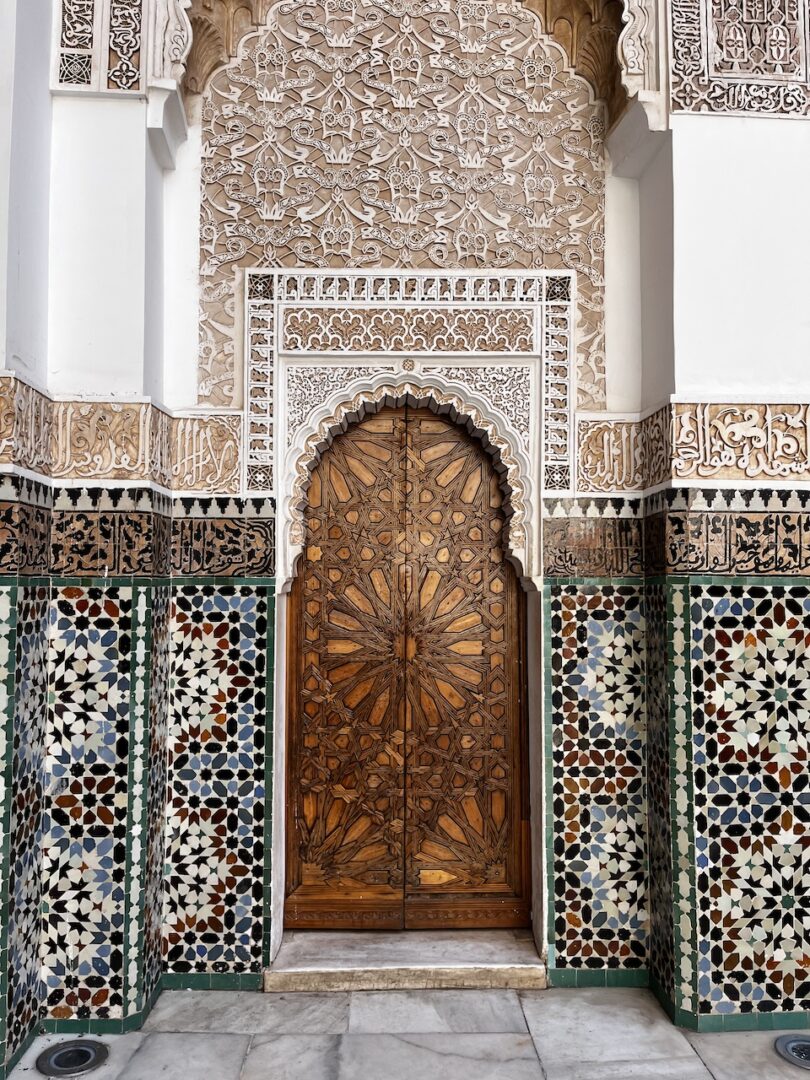
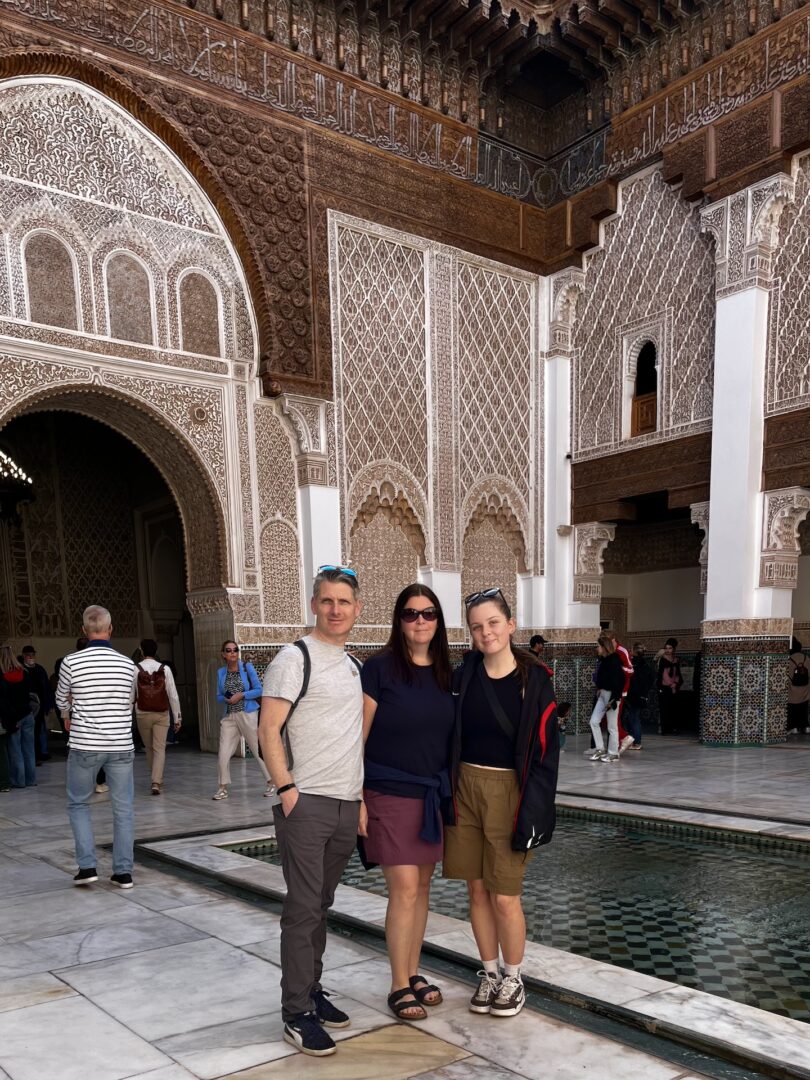
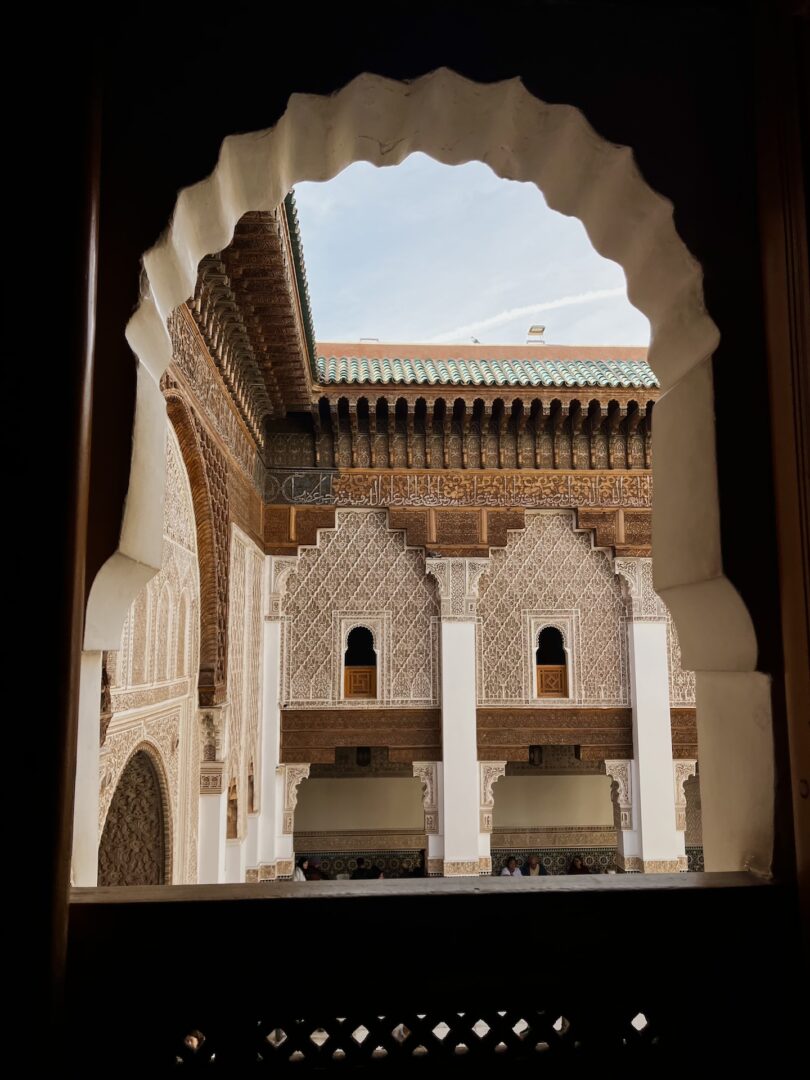
Bahia Palace
This architecturally gorgeous building is the work of Si Musa, Grand Vizier under Sultan Muhammad ibn Abd al-Rahman in the 1860s, and later expanded by his son, Abu Ahmed. The name ‘Bahia Palace’ means in Arabic ‘brilliance’, and it is indeed brilliant! It is divided into multiple different rooms such as the Hall, the 4 rooms for Abu’s wives which are equal in size (meaning all 4 wives are equal in status), the school – which is turned into a mosque 5 times a day for praying, and his quarters, as well as his very own private dining room. When Morocco gained independence from France in 1956, the Palace was used as a royal residence, until King Hassan II decided to utilise the building as a tourist attraction as well as an icon of Moroccan culture.
Bahia Palace is open every day from 9am-5pm, however, these times change during Ramadan. It costs 100 Dirhams to enter, payable by cash only.
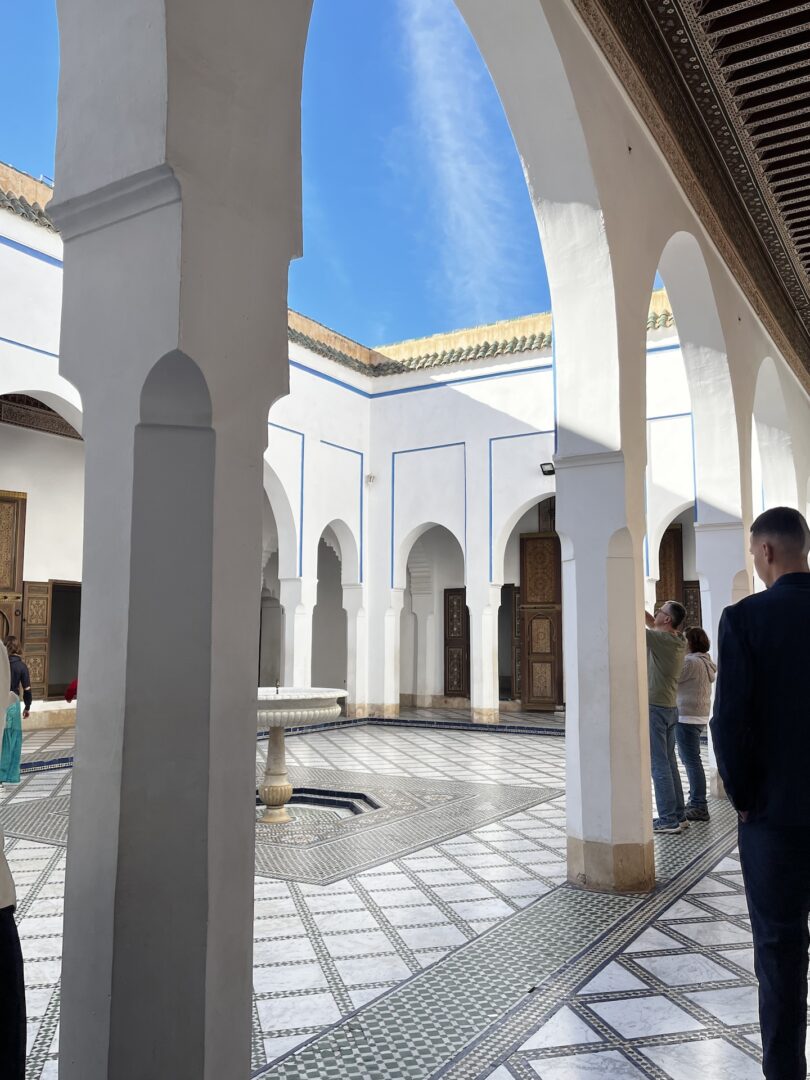
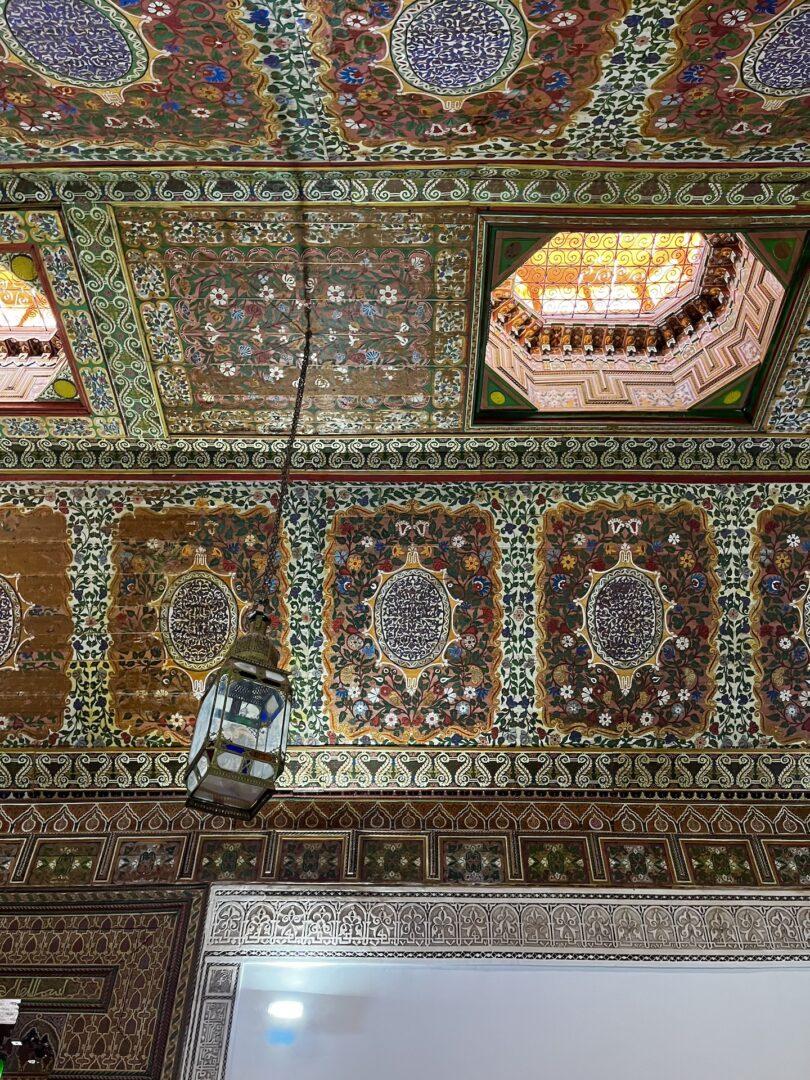
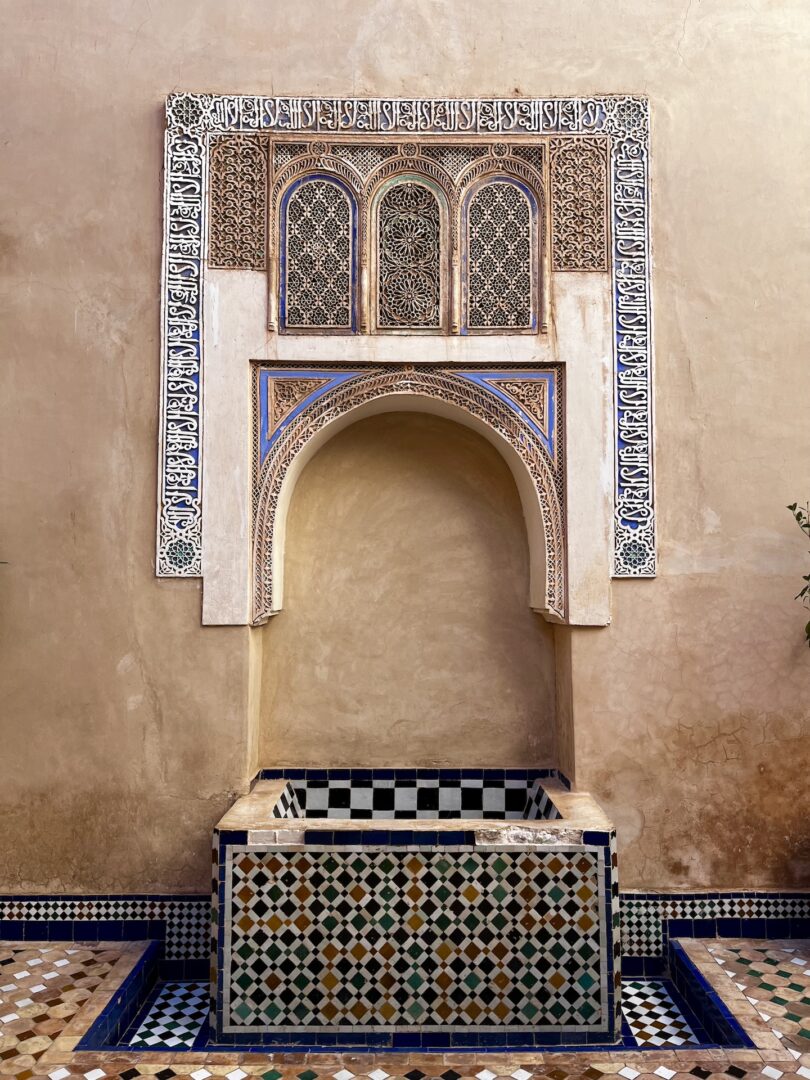
Saadian Tombs
These tombs were built in the 16th century by Sultan Ahmad al-Mansur, the third ruler of the Saadian dynasty. They were built mainly to honour the Sultan’s ancestors and were made to be a display of his power and money. The tombs are inside the Kasbah Mosque, a mosque built in 1557 and one of the oldest mosques in Morocco. There are two main sections inside the site, each containing several chambers with multiple tombs, and the most ‘important’ of these is the Chamber of the Twelve Columns, where Sultan Ahmad al-Mansur and his family are buried. They house the tombs of seven Sultans in total, alongside 62 family members and close confidants of the Saadian dynasty – a dynasty which ruled for 100 years. When the last Sultan in the Saadian dynasty passed, the new Sultan boarded up the entrance to this collection of tombs to try and forget about the previous Sultan, the huge dynasty that lived and the accomplishments that were achieved during this reign. They were hidden away for centuries, until in 1917, an aerial photo was taken and the tombs were rediscovered, almost in immaculate condition! They are now a very popular tourist site, queues to see the tombs can go on for a while. It costs 100 Dirhams to enter, expensive for how little you get to see.
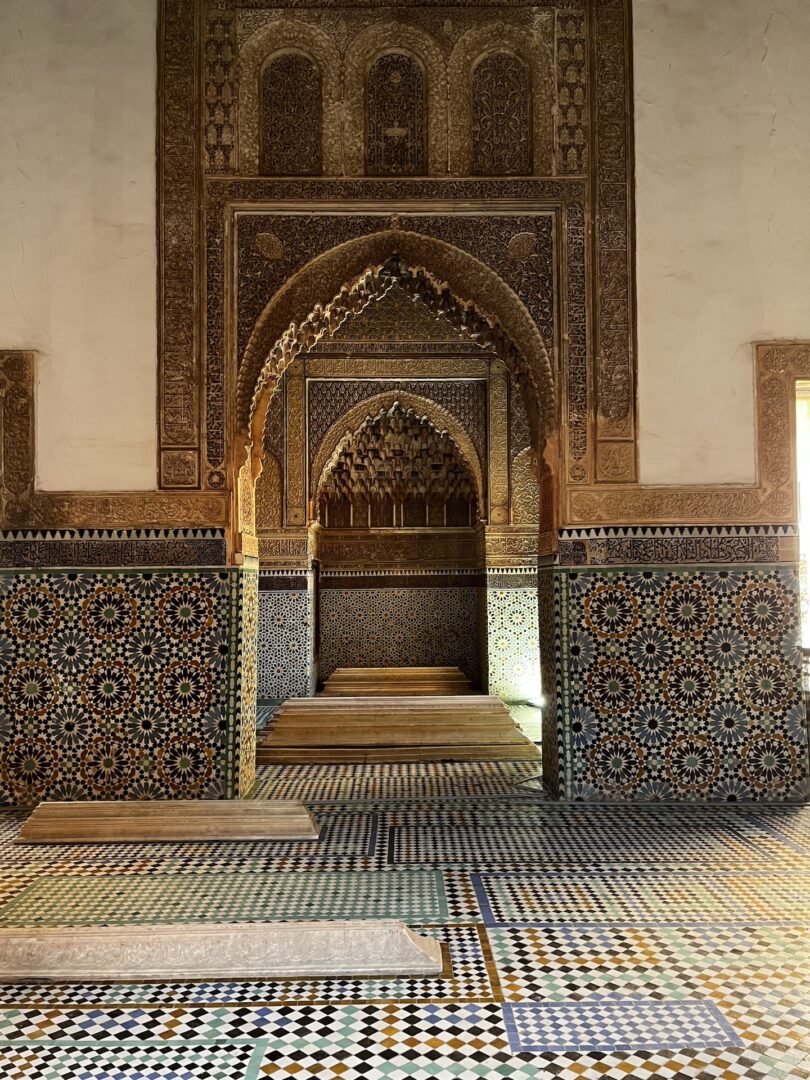
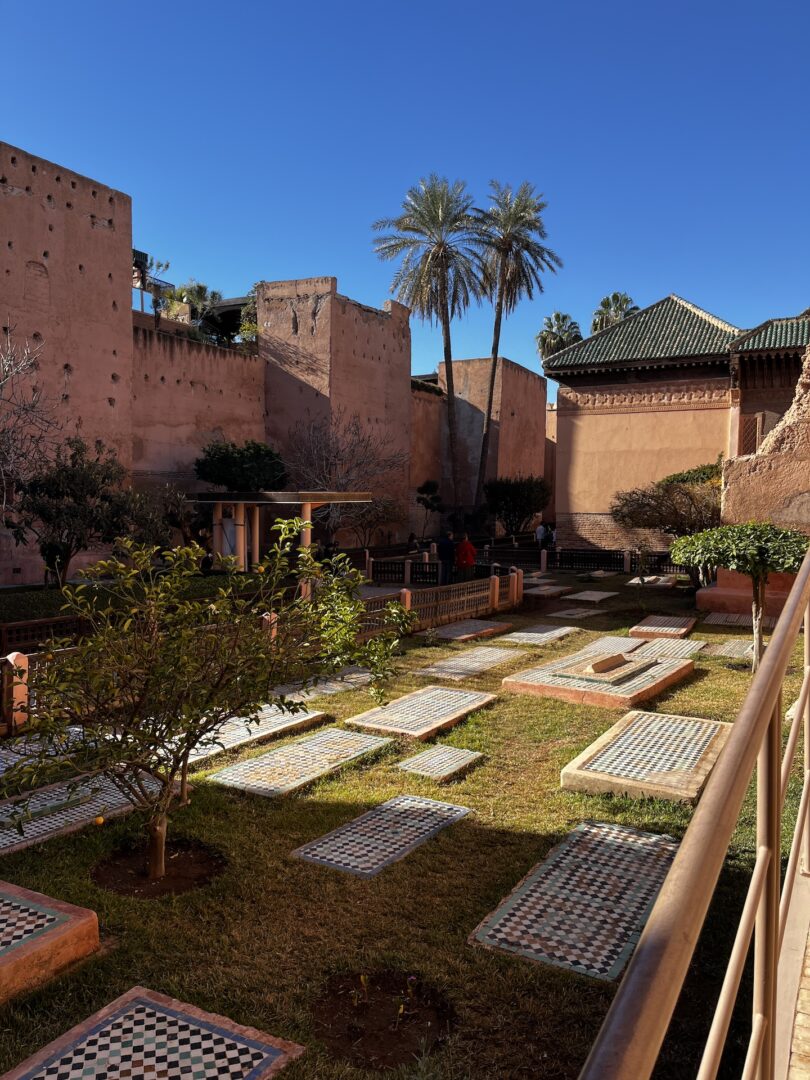
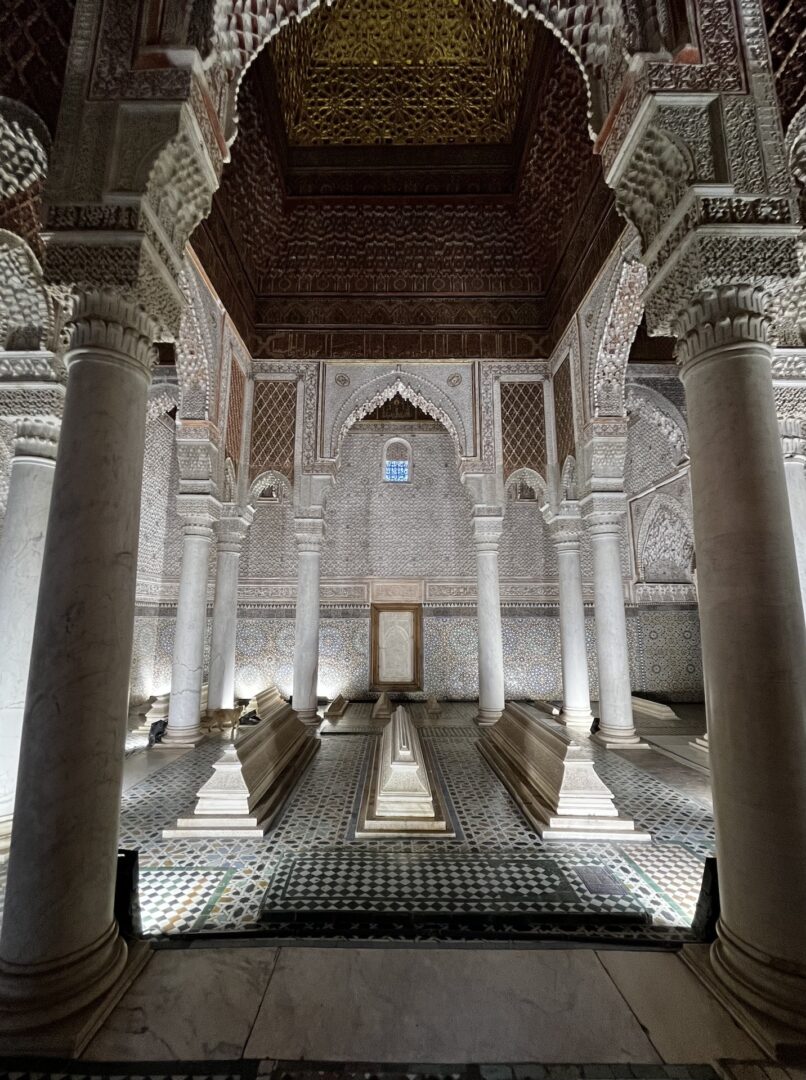
Le Jardin Secret
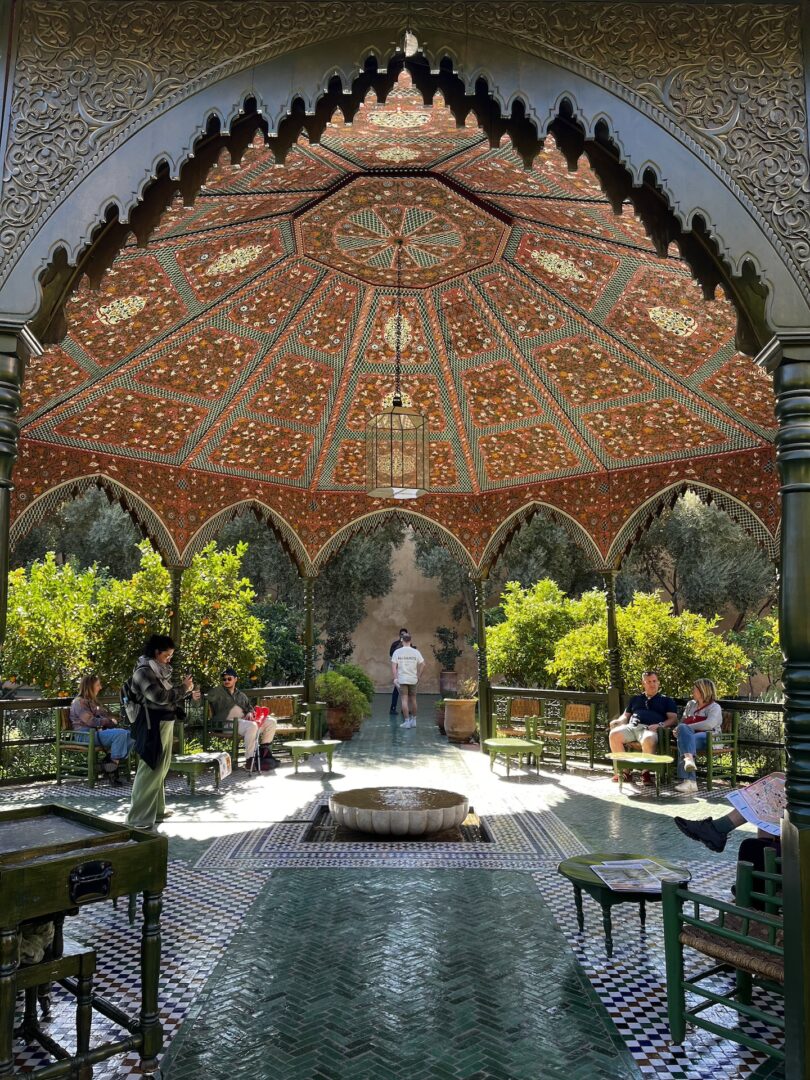
A hidden garden in the Medina, hidden behind a normal-looking wooden door! The gardens weren’t always a garden. The original structure, which surrounds them, was built over 400 years ago, but has only recently been restored, and plants have been planted after discovering the original water system. The system, a Khettara, essentially waters the plants by gravity. The gardens are divided into two sections – an exotic garden and a traditional Islamic garden with fruit trees. It costs 100 Dirhams to enter (a reduced price for those under 24 years old), which allows access to the small museum and unlimited time in the gardens. There is a cafe on-site, along with a staircase to the top of the tower with views across the Medina for an extra 40 Dirham.
Jardin Majorelle
Another garden, less hidden than Le Jardin Secret, but the opposite end of the Medina. Jacques Majorelle made this garden and used it as inspiration for his landscape paintings. In 1980, however, French fashion designer Yves Saint Laurent bought the garden to preserve it and keep Jacques’ ideas alive. It later opened to the public, and inside the grounds also include a museum, a Yves Saint Laurent museum, a cafe and a gift shop. In the centre lies the electric blue building, now home to a museum, but was originally the workshop of Jacques Majorelle, and it’s now famous for its insta-worthy photos! After Saint-Laurent passed, his ashes were scattered in these gardens by his life partner. The cost to enter the gardens alone is 170, and you pay extra if you want to visit the two museums.
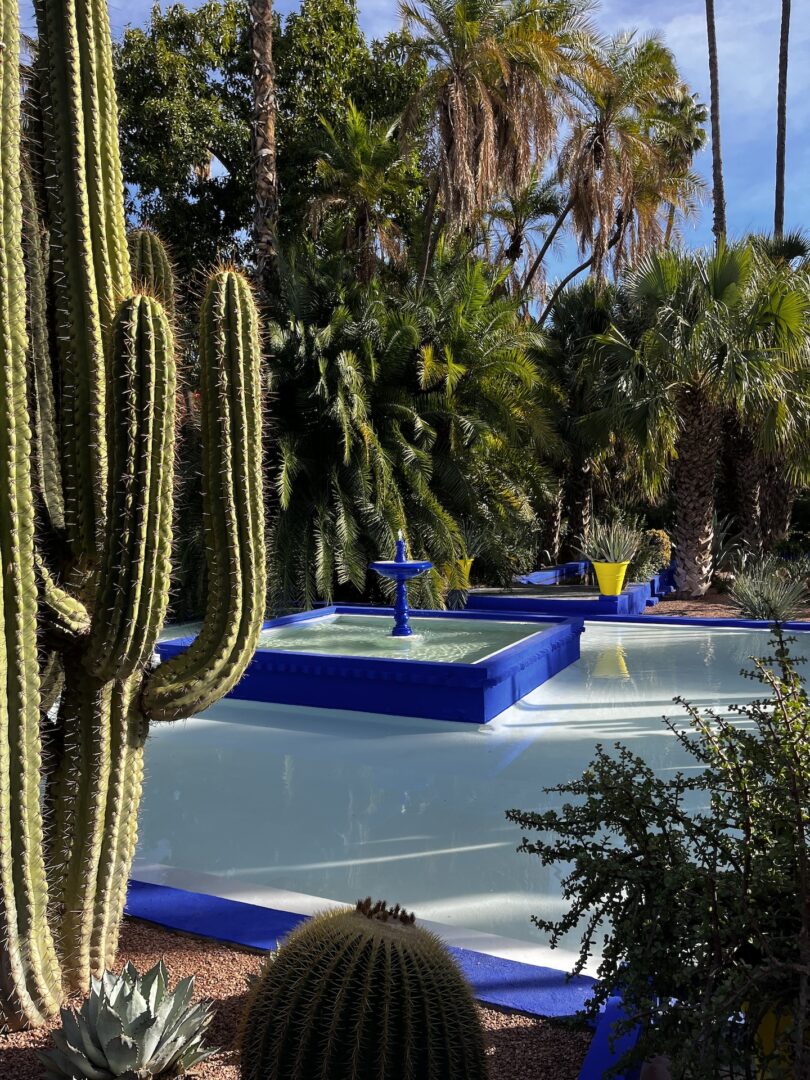
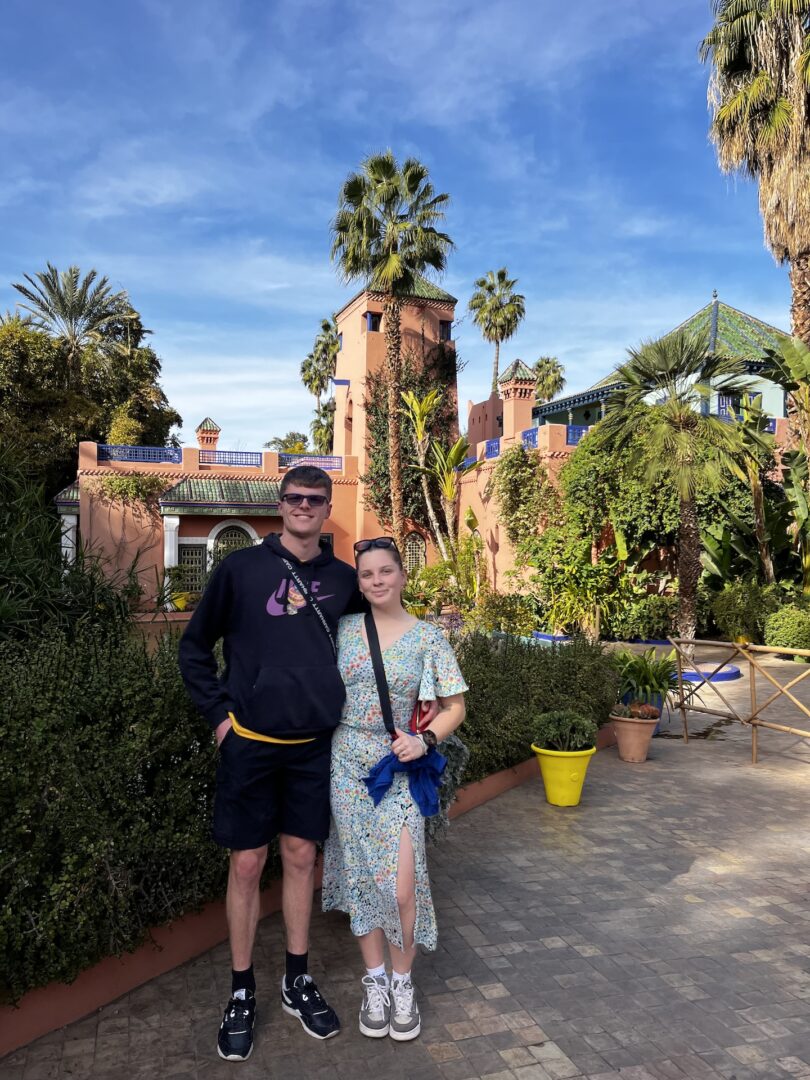
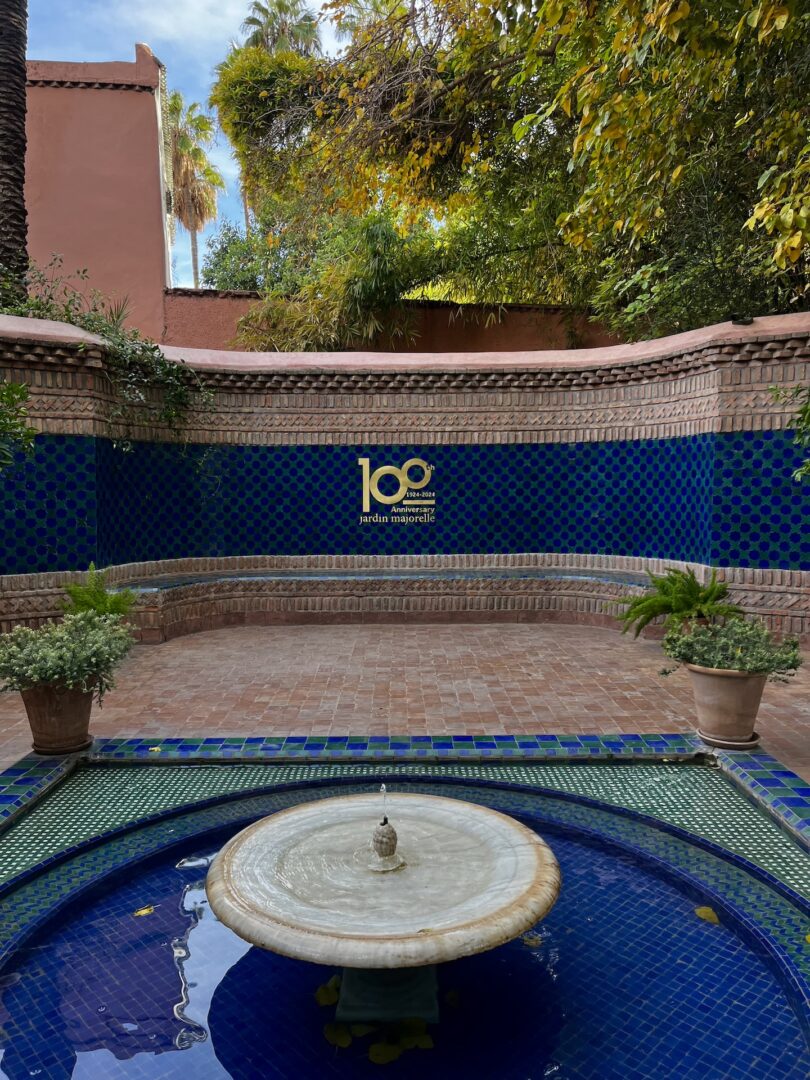
El Badi Palace
Another spectacular palace, and another spectacular history to go with it. It was commissioned to be built by Sultan Ahmed al Mansur in 1578 and took over 25 years to be finished due to the expensive and rich materials used. Materials such as onyx, gold leaf, crystal and marble made El Badi Palace fit for a king! At the beginning of the 17th century, after the last of the Saadian line had passed, the Palace was destroyed by Sultan Moulay Ismail and the materials were transported to a different city. ‘El Badi’ meaning ‘the incomparable’ was no more, and instead, the remains that we see today, along with nesting storks and orange trees, are all the public can view. The Palace is open from 9am-5pm daily, located in the Jewish Quarter of the Medina, and the entry fee is 70 Dirhams per adult.
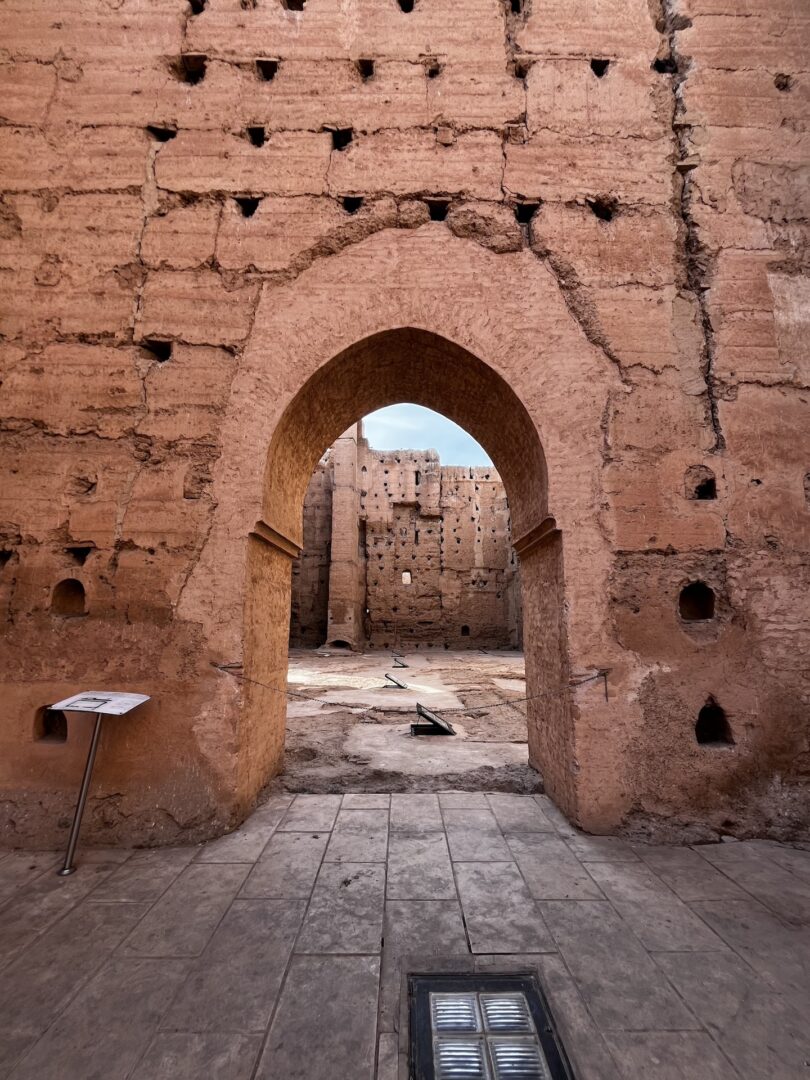
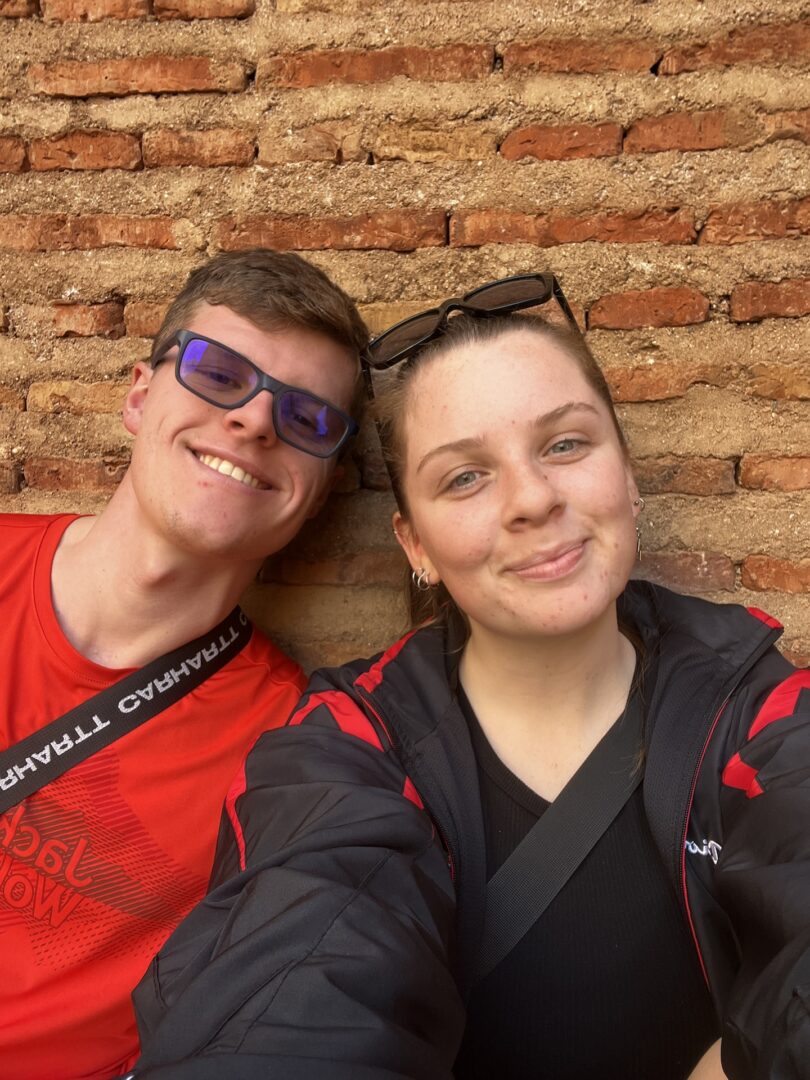
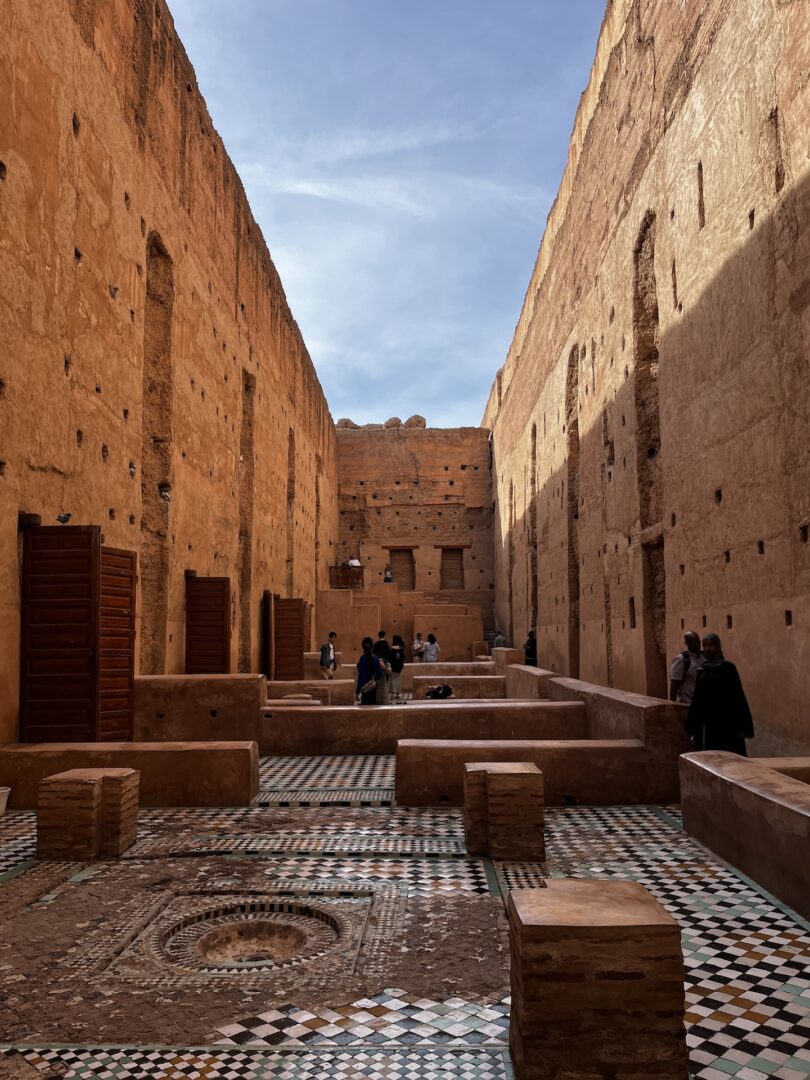
THINGS TO DO
Henna Art Cafe
Henna is a traditional art, used by multiple generations to apply designs to the skin. It is believed that henna brings good luck and protects those who have it from the evil eye. The Henna Art Cafe, nestled within the Medina has resident artists who offer multiple (when I say multiple, over a hundred!) designs which you can choose from. These range from 50-500 Dirhams, depending on size and detail. There are other places where you can get henna – multiple locals are in Jemaa el-Fnaa, however, this is a touristy spot so be careful of getting scammed and be aware of the prices elsewhere in the city.
Day trip to the Agafay Desert – Camel Riding, Quad Biking, Meal and Show
A jam-packed day if you choose to do this! Multiple buses are doing the same activities, so the order of activities will vary, depending on the timings of the other tours. We ended up doing the camel riding first – kitting up in local dressings followed by a 20-minute circular journey through part of the desert on camelback. Next up was the quad biking, a quick brief and a 45-minute ride, a chance to swap over in the middle, and a 45-minute ride back into the small town we started in. Finally, a meal at an isolated restaurant in the desert. All of these activities were pretty close to each other, so once in the area, there isn’t much driving involved. We managed to get to the restaurant just as the sun was setting, we sat down for some food and got a ‘three-course meal’. Soup and bread, a vegetable tagine followed by seasonal fruits to finish. Finally, a light show was held, demonstrated by a local performer with fire, which had us all mesmerised, and a long drive back into Marrakech ended our day.
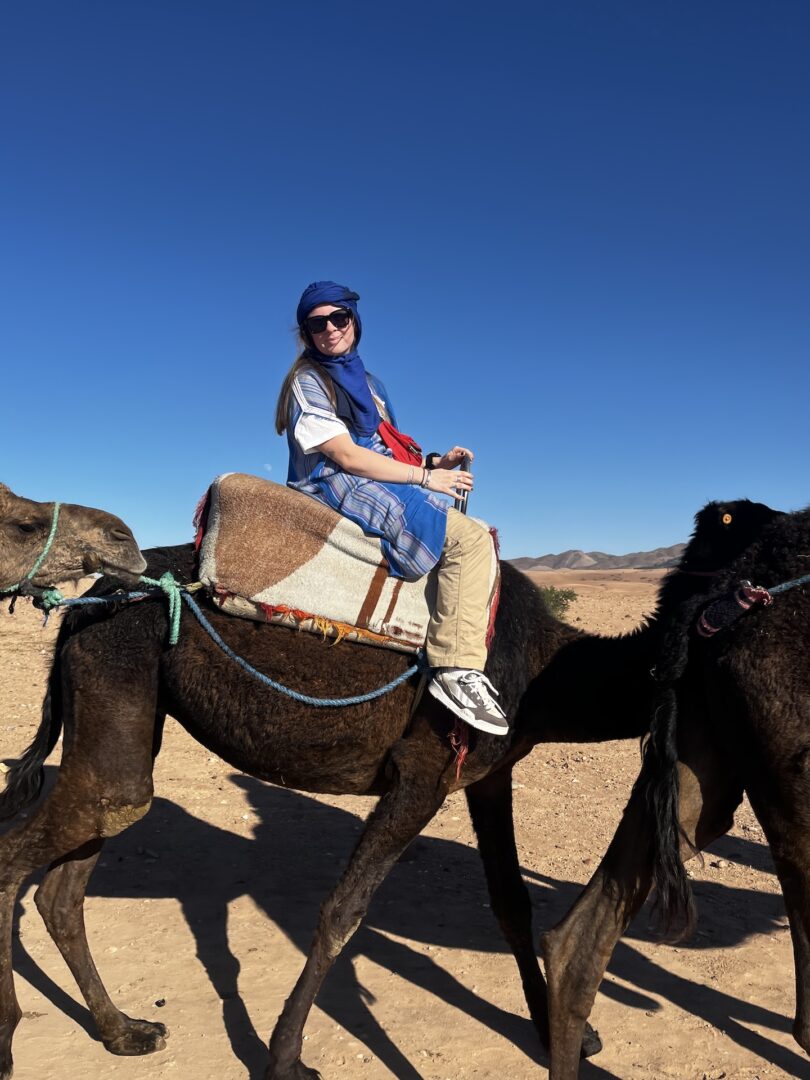
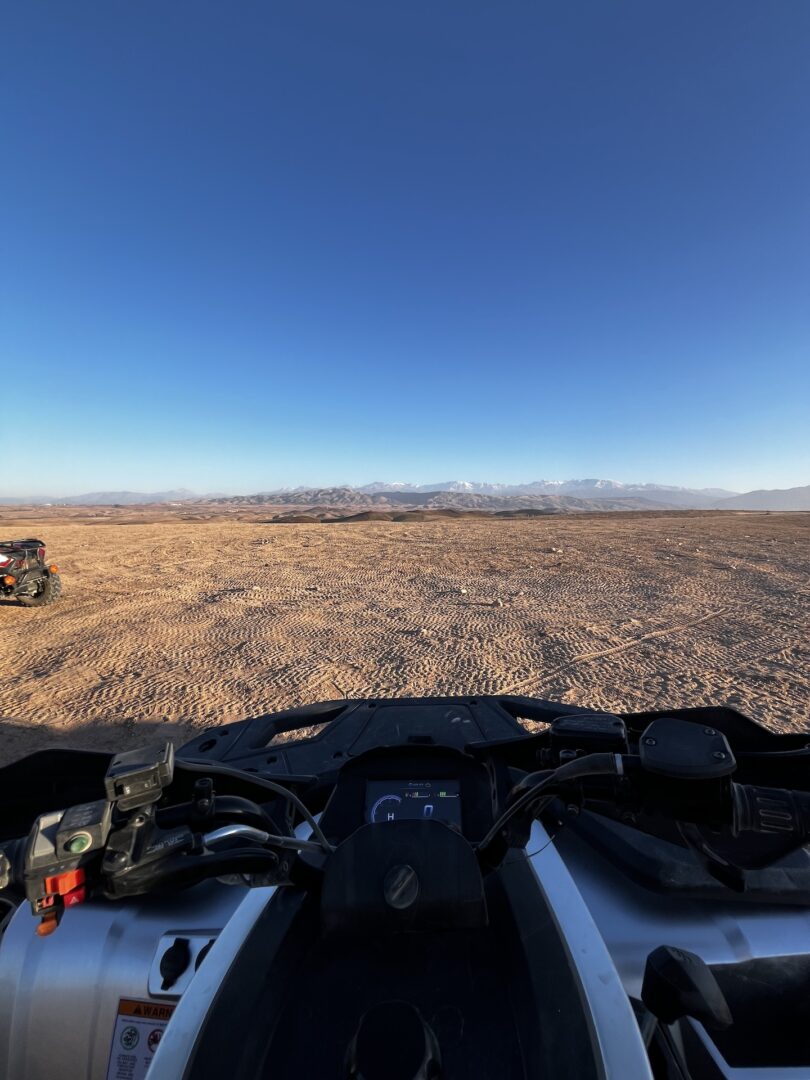
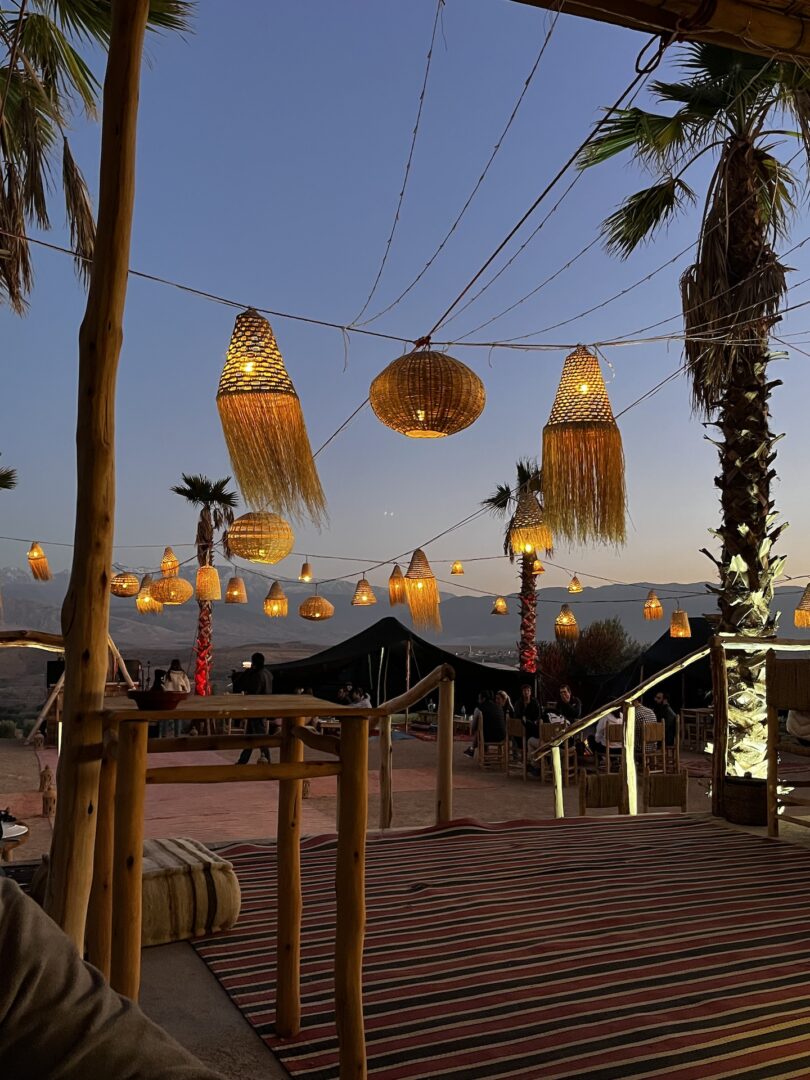
Hammam
A hammam is essentially a sauna, started by the Romans, and used in many different countries across the world. The idea is that you move through rooms which increase in heat to increase sweating, followed by a scrub to remove dead skin cells. In Marrakech, there are multiple different hammams to choose from, but it depends on what kind of experience you want. Those craving the more local and traditional experiences will need to move further outside the Medina, but those wanting an experience more tailored to a tourist, stick inside the centre.
We chose to go to Nilo Hammam, a hammam used by both tourists and locals. Prices varied depending on what you wanted, I chose a traditional hammam experience including a black body scrub and a hair wash, with a 30-minute massage also! Because it is a place that locals use, men and women are separated. Firstly, we got changed and sat in the steam room for around 30 minutes, rubbing a scrub on our skin. Then, two local workers came and took us into a different room and scrubbed our skin – so hard that I thought my tattoos were going to disappear! We were rinsed with water before the massage started, not as relaxing as planned because I went on a hike the day prior and my legs were in agony! Finally, the experience finished with an orange blossom hair wash, we got changed and headed back out to meet the boys. A bizarre but very interesting experience. People of Marrakech tend to visit 1-2 times a week to scrub themselves.
Day trip to Ait BenHaddou, Atlas Studios
We went with the provider Click Excursions, booked through Tripadvisor. The trip once again started with a pick-up from outside our accommodation, and we drove for 2 hours before reaching our first stop, Tizi n’Tichka. This was only a short stop; it was a stunning viewpoint across the whole of the valley with mountains going on for miles! About another hour and a half drive before reaching Ait Benhaddou. This is a small village built in the traditional Moroccan way, using clay for the architecture. It has since been made a UNESCO Heritage Site and is now used in multiple movies and TV series like Gladiator and Game of Thrones. To this day, five families still live in this village, the rest have moved across the river into the newer village built with modern materials as it is more practical for day-to-day life. One more drive for about 20 minutes to visit our last destination, the Atlas Studios. Here is a large collection of different movie sets, which once again, were used in many famous movies and TV series – GoT, Aladdin and Gladiator to name a few.
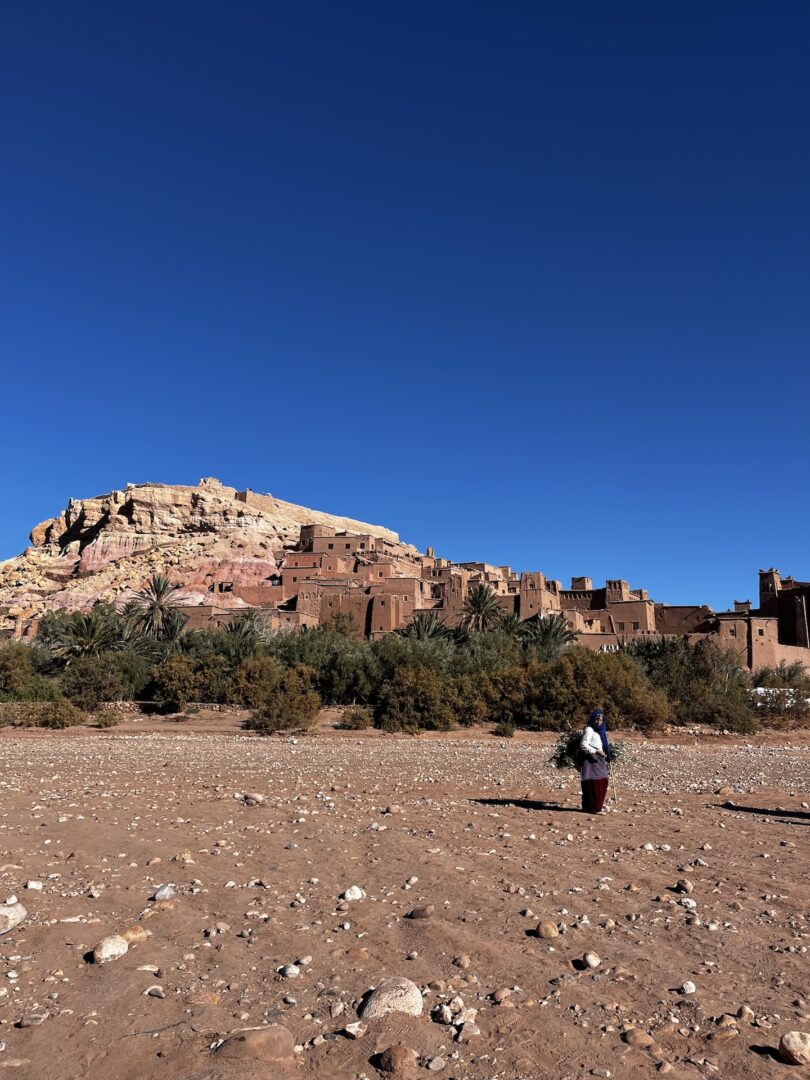
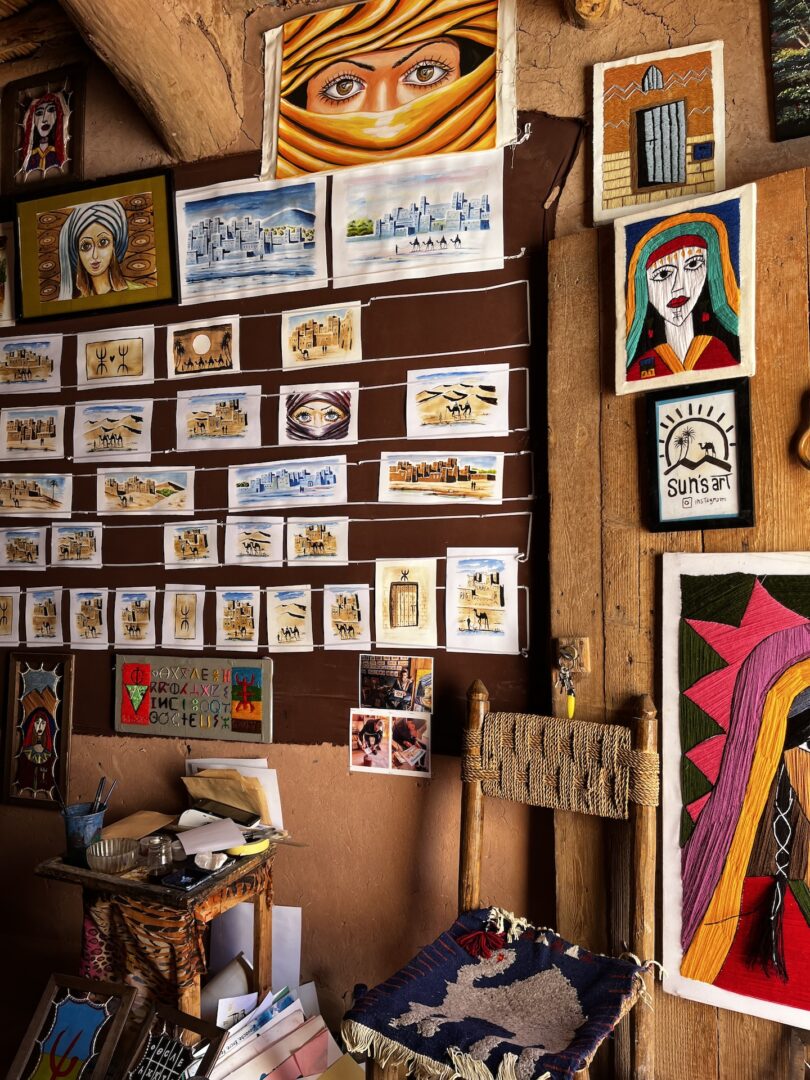
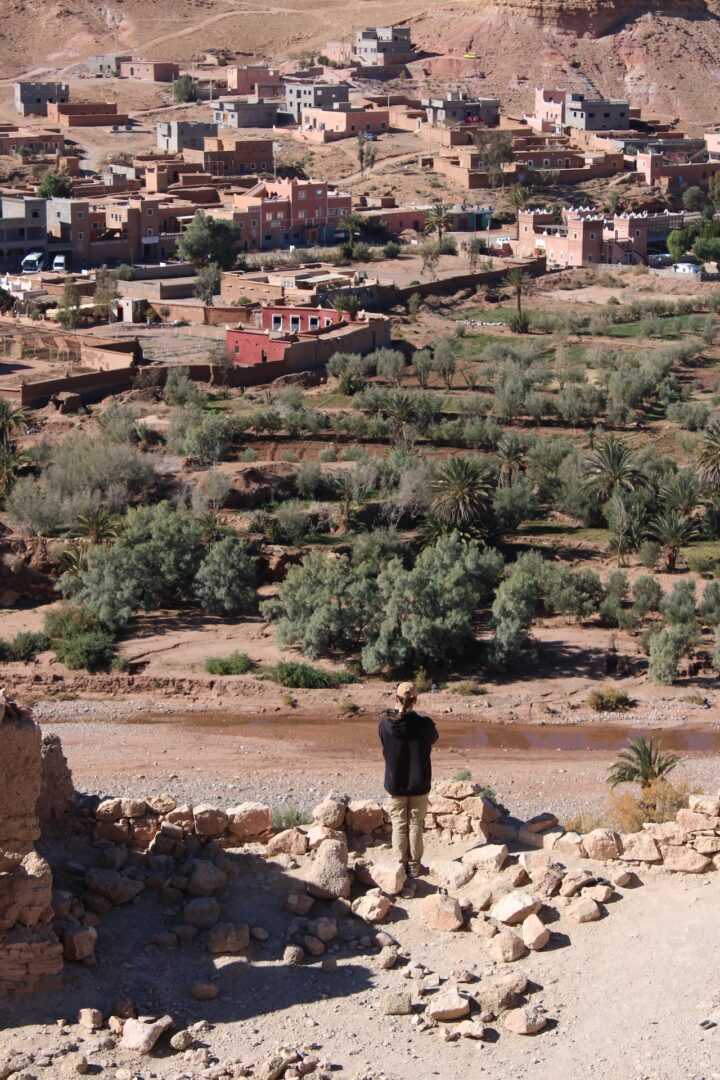
Hike in the Atlas Mountains
I am a huge fan of hiking and the outdoors, so I was itching to get into the Atlas Mountains, so close to Marrakech. The provider we went with was Moroccan Treasures, and we had Hamil as a guide. The day trip started with picking us up from just outside our accommodation, and we drove about an hour and a half into the mountains. There was an optional stop at a woman’s argan oil cooperative, but those on the minibus were happy to give it a miss as we had all already been to visit elsewhere in the country. Imlil was the start of the hike, and we trekked up to the summit of Isk, standing at 2500m tall. A picnic was provided which we ate on the summit before heading down, and because we were a small group, the guide took us back to his home in the neighbouring village for some traditional Moroccan tea! Finally, we started to head back towards the minibus to head back to Marrakech, but we went via the Imlil Waterfalls, absolutely stunning. The drive back was quieter, the hike was so hard!
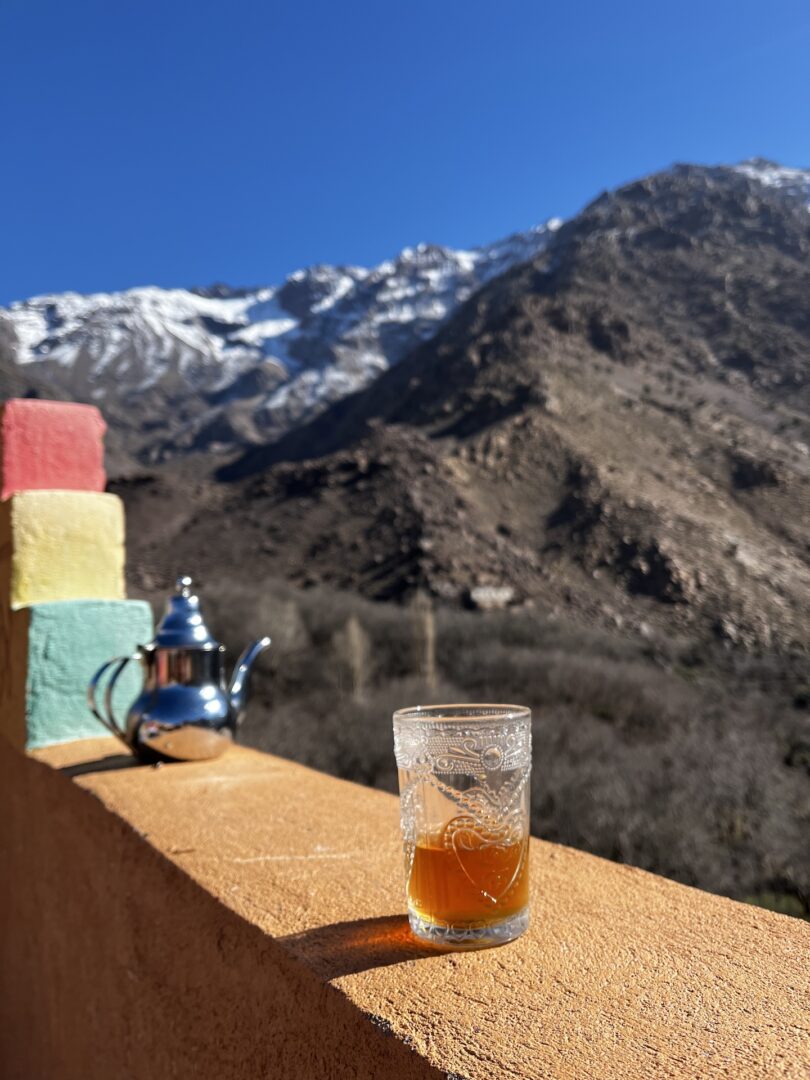
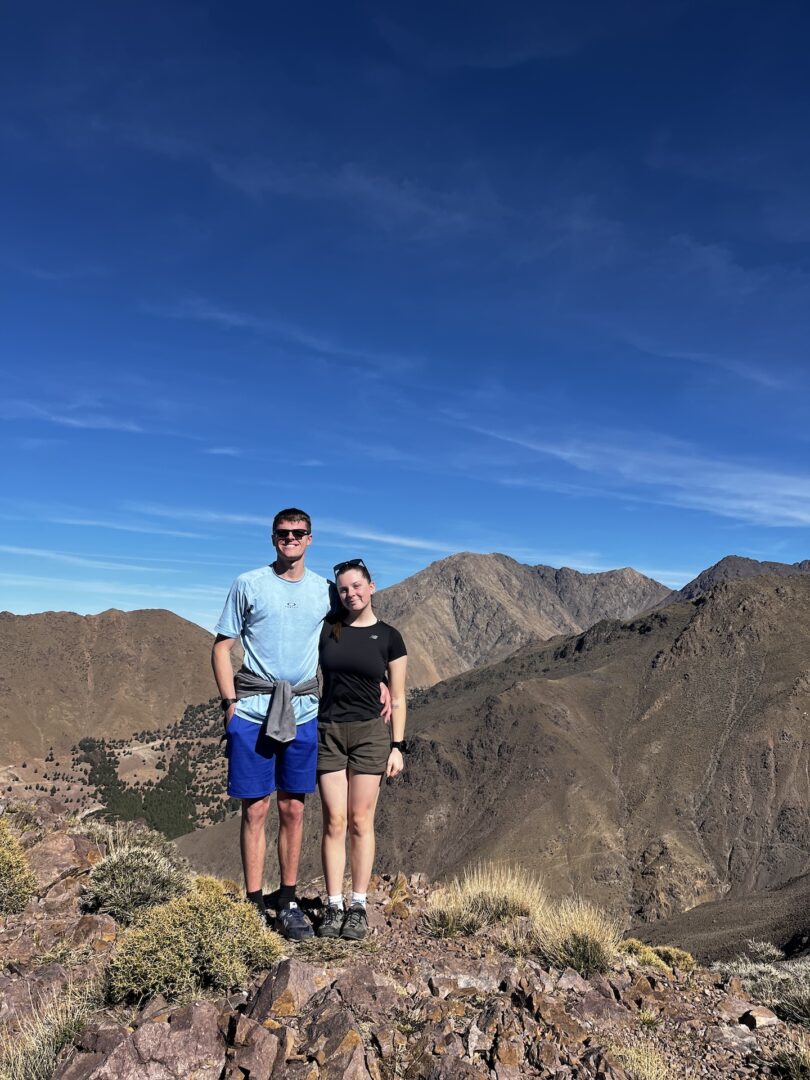
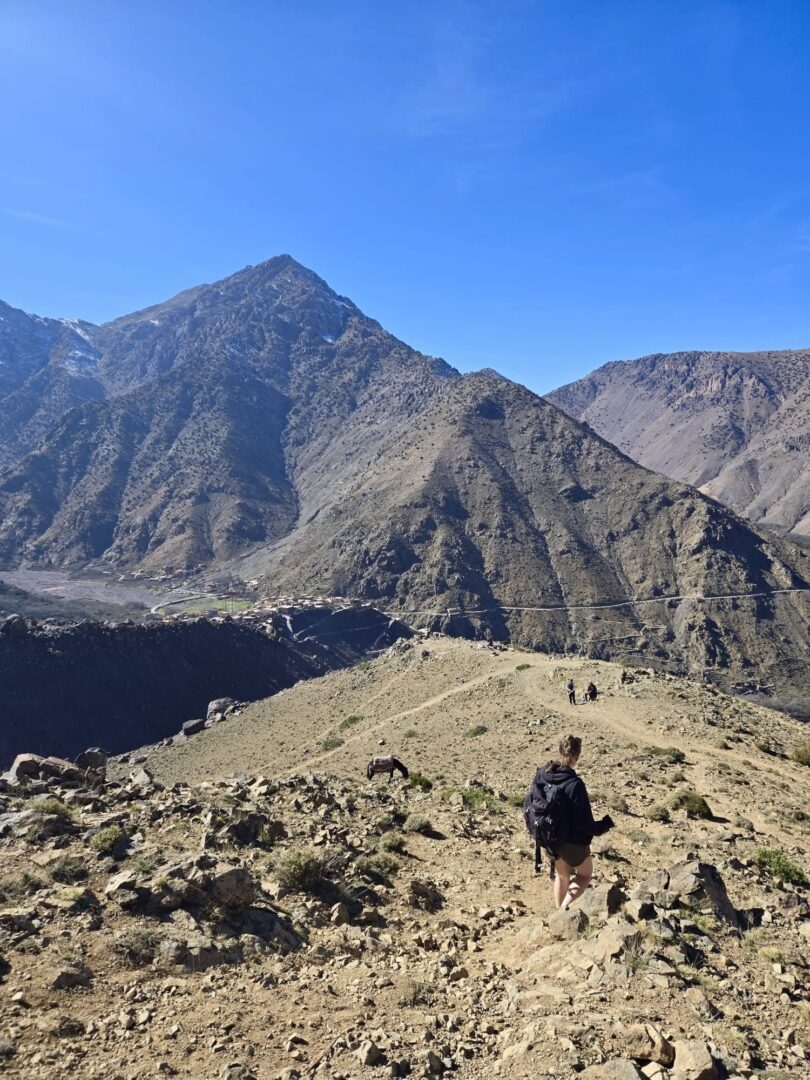
PLACES TO EAT
Breakfast
We had breakfast included in our accommodation. The meal, on the whole, is very carb-heavy: pancakes, bread, and pastries, along with hard-boiled eggs, yoghurt and jam. Different than normal but tasty all the same!
Lunch
- Simple Cafe. Located within the Medina near Ben Yousef, this serves a variety of Moroccan cuisine as well as a lot of vegetarian dishes for a low price!
- McDonald’s. A classic when you travel to a new country.
- Hamid’s Moroccan Diner. A small menu but is quick and cheap for what you get! They are happy to alter items on the menu to make them vegetarian.
Dinner
- Clock Cafe. Local to our accommodation near Bab Ksiba, this place had more of a Western feel. They serve burgers, and salad bowls, along with the traditional Moroccan dishes. There are events (like music and dancing) happening most nights, although they do ask for a small fee to watch these (around 30 Dirhams).
- Zeitoun Restaurant. There are 2 of these restaurants in the centre of the Medina – Kasbah and Jemaa el-Fnaa. They have a large menu, with plenty of options to choose from.
Snacks
- Patisserie des Princes. A fancy bakery serving the best Moroccan pastries in the Medina!
- Museum of Culinary Arts, Le Salon de Thé. Serving all kinds of tea, the traditional way. More expensive to buy tea here than elsewhere.
WHERE WE STAYED
– Riad Inaka.
USEFUL INFORMATION FOR TRAVELLING IN MOROCCO
- Morocco widely accepts 2 different currencies – Euros and Moroccan Dirham. The country was colonised by France in 1912 during the signing of the Treaty of Fez, the reason why most Moroccans speak French with each other rather than Arabic. You will hear both languages during your time here, and a lot of the population can speak some English, whether that be fluent or basic. It depends on the area of work they are in. Those working in the tourism industry can speak languages other than their own more fluently than those who have minimal interaction with foreigners.
- You need to print your boarding pass off when flying out of Marrakech Menara Airport. They require this as they do multiple checks throughout the journey to the gate. If you haven’t done this prior to your flight: you may be denied entry, it may be tricky finding a printer at the airport, and you will be charged a fee at the check-in desk for them to print you one off. The best option is to print off both your outgoing and return boarding passes before you leave for your trip, however, there are also many internet cafes in and around the Medina which can be used for this exact reason.
- Don’t be scared to haggle! It’s a big part of their culture.
- The majority of the population is Muslim, and I encourage you to respect their religion and cover up. Don’t get me wrong, those living in the middle of the Medina must be used to tourists showing more skin than normal, but be warned, expect plenty of staring, especially if you’re female.
- I travelled to Marrakech during the winter and found that it was incredibly cold during the night. Research the weather for the time you are planning on travelling and pack accordingly, I don’t know what I would have done without my trousers and hoodie! We even had the heater on at night and the thickest duvet in our room to sleep with! It reached 25 degrees during the day so we ended up having to pack for both climates, quite tricky when only taking a carry-on rucksack!
- Tips are not mandatory but are expected by everyone. They don’t add a service charge onto the end of your receipt, but mention the price and heavily hint at a tip. Even in the tourism industry, those working as tour guides ask for tips. Reviews are requested at the end of every activity too – if you book day trips then you will be asked to write a review on your way back to Marrakech there and then. Salaries aren’t high for locals so tips are greatly appreciated by them.

